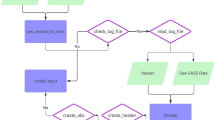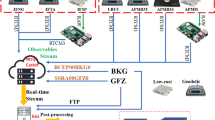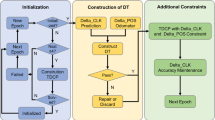Abstract
Precise satellite orbit and clock corrections are essential to precise point positioning (PPP). The standard GPS legacy navigation (LNAV) message disseminated by the satellite is one of the most widely used sources for deriving orbit and clock corrections in real-time using efficient analytical user algorithms. However, the quality of the satellite orbit and clock corrections computed with the standard LNAV is not adequate for real-time PPP mainly due to the low update rate. In this study, we proposed an improved LNAV which is estimated based on the IGS ultra-rapid (IGU) orbit and real-time service (RTS) clock products. Two advantages characterize this improved LNAV message. The first one is that scalable update rates can be used for disseminating satellite orbit and clock corrections. Users can decide to receive and decode the improved LNAV message at the desired update rate considering the availability of correction streams, communication bandwidth, and targeted accuracy. With sufficiently high update rates, the improved LNAV can be applied for high-precision applications such as real-time PPP. The second advantage is that the legacy user algorithms can be maintained for computing real-time satellite orbit and clock corrections. Since the improved LNAV has the same parameter representation as the standard LNAV, no changes are required at the user algorithms. To validate the proposed method, the quality of real-time orbit and clock corrections computed with the improved LNAV, IGU products, Centro Nacional de Estudios Espaciales (CNES) real-time products, and the standard LNAV is compared, while the IGS final products are used as the reference. The numerical results indicate that the improved LNAV can achieve comparable orbit accuracy as CNES real-time products, while the clock accuracy highly depends on the update rate. A globally distributed network of 40 IGS stations is used to assess the kinematic PPP performance. Using the improved LNAV with update intervals of 5 min, an average positioning accuracy of 0.122, 0.100, and 0.242 m at 95% confidence level can be obtained in the east, north, and up directions, respectively. Even when the update intervals extend to 2 h, the positioning accuracy is still about 1.2 times better than that of using IGU products. The proposed method provides a scalable and flexible way to improve the standard LNAV for real-time PPP users.











Similar content being viewed by others
References
Allan DW (1987) Time and frequency (time-domain) characterization, estimation, and prediction of precision clocks and oscillators. IEEE Trans Ultrason Ferroelectr Freq Control 34(6):647–654
Bisnath S, Gao Y (2008) Current state of precise point positioning and future prospects and limitations. IAG Symp 133:615–623
Böhm J, Niell A, Tregoning P, Schuh H (2006) Global mapping function (GMF): a new empirical mapping function based on numerical weather model data. Geophys Res Lett 33(7):L07304
Caissy M, Weber G, Agrotis L, Wübbena G, Hernandez-Pajares M (2011) The IGS real-time pilot project—the development of real-time IGS correction products for precise point positioning. In: EGU General Assembly, Geophysics Research Abstracts 13, EGU2011-7472
Dierendonck AJV, Russell SS, Kopitzke ER, Birnbaum M (1978) The GPS navigation message. Navigation 25(2):147–165
Dow JM, Neilan RE, Rizos C (2009) The International GNSS Service in a changing landscape of global navigation satellite systems. J Geod 83(3–4):191–198
Du L, Zhang Z, Zhang J, Liu L, Guo R, He F (2015) An 18-element GEO broadcast ephemeris based on non-singular elements. GPS Solut 19(1):49–59
El-Mowafy A, Deo M, Kubo N (2017) Maintaining real-time precise point positioning during outages of orbit and clock corrections. GPS Solut 21(3):937–947
Fu X, Wu M (2012) Optimal design of broadcast ephemeris parameters for a navigation satellite system. GPS Solut 16(4):439–448
Gao Y, Zhang W, Li Y (2016) A new method for real-time PPP correction updates. In: International symposium on earth and environmental sciences for future generations, IAG Symp 147, p 223
Hadas T, Bosy J (2015) IGS RTS precise orbits and clocks verification and quality degradation over time. GPS Solut 19(1):93–105
Herring TA, King RW, McClusky SC (2010) Introduction to GAMIT/GLOBK. Massachusetts Institute of Technology, Cambridge
Heßelbarth A, Wanninger L (2013) SBAS orbit and satellite clock corrections for precise point positioning. GPS Solut 17(4):465–473
Kazmierski K, Sośnica K, Hadas T (2018) Quality assessment of multi-GNSS orbits and clocks for real-time precise point positioning. GPS Solut 22(1):11
Kouba J (2009) A guide to using International GNSS Service (IGS) products
Li L, Jia C, Zhao L, Cheng J, Liu J, Ding J (2016) Real-time single frequency precise point positioning using SBAS corrections. Sensors 16(8):1261
Malys S, Jensen PA (1990) Geodetic point positioning with GPS carrier beat phase data from the CASA UNO Experiment. Geophys Res Lett 17(5):651–654
Montenbruck O, Steigenberger P, Hauschild A (2015) Broadcast versus precise ephemerides: a multi-GNSS perspective. GPS Solut 19(2):321–333
Nie Z, Gao Y, Wang Z, Ji S, Yang H (2018) An approach to GPS clock prediction for real-time PPP during outages of RTS stream. GPS Solut 22(1):14
Petit G, Luzum B (2010) IERS conventions (2010), IERS Technical Note 36. Verlag des Bundesamts für Kartographie und Geodäsie, Frankfurt am Main
RTCM Special Committee (2016) RTCM Standard 10403.3 differential GNSS (Global Navigation Satellite Systems) Services-Version 3. RTCM Special Committee No. 104, Arlington
Schmid R, Steigenberger P, Gendt G, Ge M, Rothacher M (2007) Generation of a consistent absolute phase-center correction model for GPS receiver and satellite antennas. J Geod 81(12):781–798
Springer TA, Hugentobler U (2001) IGS ultra rapid products for (near-) real-time applications. Phys Chem Earth 26(6–8):623–628
Takasu T (2013) RTKLIB ver. 2.4.2 Manual. 2013 edn. Tokyo University of Marine Science and Technology, Tokyo
U.S. Air Force (2015) Global Positioning Systems Directorate Systems Engineering and Integration Interface Specification IS-GPS-200
Weber G, Dettmering D, Gebhard H (2005) Networked Transport of RTCM via Internet Protocol (NTRIP). IAG Symp 128:60–64
Wu JT, Wu SC, Hajj GA, Bertiger W, Lichten SM (1992) Effects of antenna orientation on GPS carrier phase. Adv Astronaut Sci 76(2):1647–1660
Xiao G, Sui L, Heck B, Zeng T, Tian Y (2018) Estimating satellite phase fractional cycle biases based on Kalman filter. GPS Solut 22(3):82
Yang H, Xu C, Gao Y (2017) Analysis of GPS satellite clock prediction performance with different update intervals and application to real-time PPP. Surv Rev 23:1–10
Zhang X, Li X, Guo F (2011) Satellite clock estimation at 1 Hz for realtime kinematic PPP applications. GPS Solut 15(4):315–324
Zhang L, Yang H, Gao Y, Yao Y, Xu C (2018) Evaluation and analysis of real-time precise orbits and clocks products from different IGS analysis centers. Adv Space Res 61(12):2942–2954
Zumberge JF, Heflin MB, Jefferson DC, Watkins MM, Webb FH (1997) Precise point positioning for the efficient and robust analysis of GPS data from large networks. J Geophys Res 102(B3):5005–5017
Acknowledgements
The IGS and CNES are acknowledged for providing the GNSS products. The study is partly supported by National Natural Science Foundation of China (Nos. 41774038, 41804034). The first author is funded by the China Scholarship Council and the Natural Sciences and Engineering Research Council of Canada (NSERC) which are also acknowledged. The authors also thank the editor and the anonymous reviewers for their helpful suggestions.
Author information
Authors and Affiliations
Corresponding author
Additional information
Publisher’s Note
Springer Nature remains neutral with regard to jurisdictional claims in published maps and institutional affiliations.
Rights and permissions
About this article
Cite this article
Zhou, P., Yang, H., Xiao, G. et al. Estimation of GPS LNAV based on IGS products for real-time PPP. GPS Solut 23, 27 (2019). https://doi.org/10.1007/s10291-018-0820-0
Received:
Accepted:
Published:
DOI: https://doi.org/10.1007/s10291-018-0820-0




